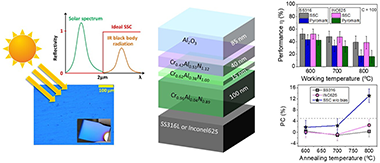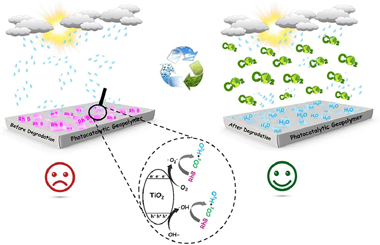Scientific Papers in SCI
2024
2024
Nanotecnología en Superficies y Plasma
Harnessing a Vibroacoustic Mode for Enabling Smart Functions on Surface Acoustic Wave Devices - Application to Icing Monitoring and Deicing
Karimzadeh, A; Weissker, U; del Moral, J; Winkler, A; Borrás, A; González-Elipe, AR; Jacob, SAdvanced Materials Technologies, (2024) 2301749
Show abstract ▽
Microacoustic wave devices are essential components in the radio frequency (RF) electronics and microelectromechanical systems (MEMS) industry with increasing impact in various sensing and actuation applications. Reliable and smart operation of acoustic wave devices at low costs will cause a crucial advancement. Herein, this study presents the enablement of temperature and mechanical sensing capabilities in a Rayleigh-mode standing surface acoustic wave (sSAW) chip device by harnessing an acoustic shear-thickness dominant wave (SD) using the same set of electrodes. Most importantly, this mode is excited by switching the polarity of the sSAW transducer electrodes by simple electronics, allowing for direct and inexpensive compatibility with an existing setup. The method in the emergent topic of surface de-icing is validated by continuously monitoring temperature and liquid–solid water phase changes using the SD mode, and on-demand Rayleigh-wave deicing with a negligible energy cost. The flexibility for adapting the system to different scenarios, and loads and the potential for scalability opens the path to impact in lab-on-a-chip, internet of things (IoT) technology, and sectors requiring autonomous acoustic wave actuators.
February, 2024 | DOI: 10.1002/admt.202301749
Química de Superficies y Catálisis
Optimizing biogas methanation over nickel supported on ceria-alumina catalyst: Towards CO2-rich biomass utilization for a negative emissions society
González-Arias, J; Torres-Sempere, G; Arroyo-Torralvo, F; Reina, TR; Odriozola, JAEnrironmental Research, 242 (2024) 117735
Show abstract ▽
Biogas methanation emerges as a prominent technology for converting biogas into biomethane in a single step. Furthermore, this technology can be implemented at biogas plant locations, supporting local economies and reducing dependence on large energy producers. However, there is a lack of comprehensive studies on biogas methanation, particularly regarding the technical optimization of operational parameters and the profitability analysis of the overall process. To address this gap, our study represents a seminal work on the technical optimization of biogas methanation obtaining an empirical model to predict the performance of biogas methanation. We investigate the influence of operational parameters, such as reaction temperature, H2/CO2 ratio, space velocity, and CO2 share in the biogas stream through an experimental design. Based on previous research we selected a nickel supported on ceria-alumina catalyst; being nickel a benchmark system for methanation process such selection permits a reliable data extrapolation to commercial units. We showcase the remarkable impact of studied key operation parameters, being the temperature, the most critical factor affecting the reaction performance (ca. 2 to 5 times higher than the second most influencing parameter). The impact of the H2/CO2 ratio is also noticeable. The response surfaces and contour maps suggest that a temperature between 350 and 450 degrees C and an H2/CO2 ratio between 2.5 and 3.2 optimize the reaction performance. Further experimental tests were performed for model validation and optimization leading to a reliable predictive model. Overall, this study provides validated equations for technology scaling-up and techno-economic analysis, thus representing a step ahead towards real-world applications for bio-methane production.
February, 2024 | DOI: 10.1016/j.envres.2023.117735
Nanotecnología en Superficies y Plasma
Synergistic Integration of Nanogenerators and Solar Cells: Advanced Hybrid Structures and Applications
Hajra, S; Ali, A; Panda, S; Song, HW; Rajaitha, PM; Dubal, D; Borras, A; In-Na, P; Vittayakorn, N; Vivekananthan, V; Kim, HJ; Divya, S; Oh, THAdvanced Energy Materials, (2024) 2400025
Show abstract ▽
The rapid growth of global energy consumption and the increasing demand for sustainable and renewable energy sources have urged vast research into harnessing energy from various sources. Among them, the most promising approaches are nanogenerators (NGs) and solar cells (SCs), which independently offer innovative solutions for energy harvesting. This review paper presents a comprehensive analysis of the integration of NGs and SCs, exploring advanced hybrid structures and their diverse applications. First, an overview of the principles and working mechanisms of NGs and SCs is provided for seamless hybrid integrations. Then, various design strategies are discussed, such as piezoelectric and triboelectric NGs with different types of SCs. Finally, a wide range of applications are explored that benefit from the synergistic integration of NGs and SCs, including self-powered electronics, wearable devices, environmental monitoring, and wireless sensor networks. The potential for these hybrid systems is highlighted to address real-world energy needs and contribute to developing sustainable and self-sufficient technologies. In conclusion, this review provides valuable insights into the state-of-the-art developments in NGs and SCs integration, shedding light on advanced hybrid structures and their diverse applications.
February, 2024 | DOI: 10.1002/aenm.202400025
Tribología y Protección de Superficies
Synthesis and Characterization of Multilayered CrAlN/Al2O3 Tandem Coating Using HiPIMS for Solar Selective Applications at High Temperature
Sánchez-Pérez, M; Rojas, TR; Reyes, DF; Ferrer, FJ; Farchado, M; Morales, A; Escobar-Galindo, R; Sánchez-López, JCACS Applied Energy Materials, 7 (2024) 438-449
Show abstract ▽

The effect of applying a negative bias during deposition of a previously designed multilayer solar selective absorber coating was studied on two types of substrates (316L stainless steel and Inconel 625). The solar selective coating is composed of different chromium aluminum nitride layers deposited using a combination of radiofrequency (RF), direct current (DC), and high-power impulse magnetron sputtering (HiPIMS) technologies. The chemical composition is varied to generate an infrared reflective/absorber layer (with low Al addition and N vacancies) and two CrAlN intermediate layers with medium and high aluminum content (Al/Cr = 0.6 and 1.2). A top aluminum oxide layer (Al2O3) is deposited as an antireflective layer. In this work, a simultaneous DC-pulsed bias (−100 V, 250 kHz) was applied to the substrates in order to increase the film density. The optical performance, thermal stability, and oxidation resistance was evaluated and compared with the performance obtained with similar unbiased coating and a commercial Pyromark paint reference at 600, 700, and 800 °C. The coating remained stable after 200 h of annealing at 600 °C, with solar absorptance (α) values of 93% and 92% for samples deposited on stainless steel and Inconel, respectively, and a thermal emittance ε25°C of 18%. The introduction of additional ion bombardment during film growth through bias assistance resulted in increased durability, thermal stability, and working temperature limits compared with unbiased coatings. The solar-to-mechanical energy conversion efficiency at 800 °C was found to be up to 2 times higher than Pyromark at C = 100 and comparable at C = 1000.
February, 2024 | DOI: 10.1021/acsaem.3c02310
Materiales Avanzados
Synthesis and characterization of porous and photocatalytic geopolymers based on natural clay: Enhanced properties and efficient Rhodamine B decomposition
Ettahiri, Y; Bouna, L: Brahim, A; Benlhachemi, A; Bakiz, B; Sánchez-Soto, PJ; Eliche-Quesada, D; Pérez-Villarejo, LApplied Materials Today, 36 (2024) 102048
Show abstract ▽

In this work, the incorporation of anatase TiO2 semiconductor in the geopolymer matrix as catalytic materials has been studied. The most noteworthy results obtained from the synthesis of a novel TiO2/geopolymer nanocomposite as an effective ecological catalyst with high thermal stability and significant porosity is presented. The porous and photocatalytic geopolymers based natural clay rich in pyrophyllite and kaolinite minerals were prepared by simple method, the geopolymerization reaction was able to successfully load TiO2 nanoparticles into the geopolymer surface. Furthermore, the results indicate that the prepared catalyst achieved the best performance to degrade Rhodamine B (RhB) molecules present in aqueous solution under UV light irradiation. The geopolymer matrix proved to be a reusable support for TiO2 nanoparticles during the photocatalytic process, efficiently facilitating the separation of photogenerated charges. Finally, the physicochemical and morphological properties of the samples was characterized by several techniques, namely X-ray Fluorescence (XRF), X-ray diffraction (XRD), Fourier Transform Infrared spectroscopy (FTIR), Thermogravimetric and Differential Thermal Analysis (TGA/DTA), N2 adsorption/desorption isotherm analysis (BET and BJH methods), UV–Vis Diffuse Reflectance Spectroscopy (DRS), Scanning Electron Microscopy (SEM) coupled to an Energy Dispersive X-ray Spectroscopy (EDS) analyzer and Transmission Electron Microscopy (TEM).
February, 2024 | DOI: 10.1016/j.apmt.2023.102048
- ‹ previous
- 3 of 410
- next ›














